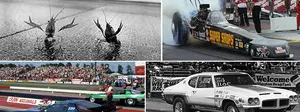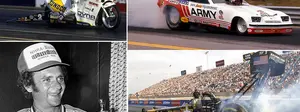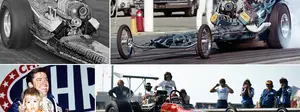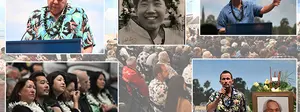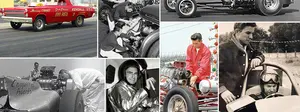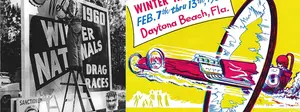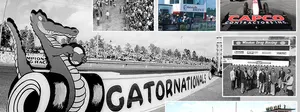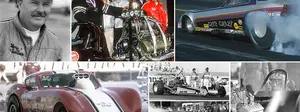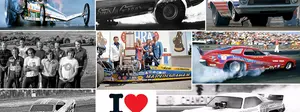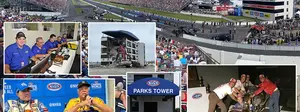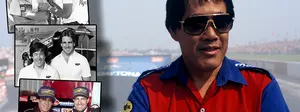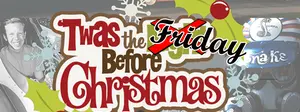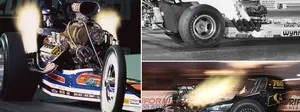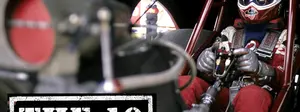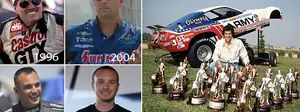Double the exposure, double the fun
Continuing our theme of trick photo shoots, I found a collection of great photos online somewhere (exactly where escapes my already-in-Englishtown brain) that are best described as see-throughs. Also called cutaways and double exposures by those in the biz, they were very popular in the late 1960s and early 1970s and are still used today. What they portray is an X-ray-type effect showing what’s under the body (usually of a Funny Car) while still giving a hint of what the body is. Today, I could probably whip up one of these in about a minute with Photoshop, but “back then,” it took a lot more skill, planning, and patience.
Steve Reyes explained his procedure: “This process is a double exposure on one piece of film. I used my Hasselblad 500cm, which had a removable back/film holder. You pose the car with camera on tripod. Next you have the car put up on jack stands; this prevents the car from sinking when the body is placed on the chassis. If the car sinks just the slightest, the photo will be ruined. Then you shoot it either with the body on or off. You take one exposure and pull the back off the camera, wind the film back, and place the back on the camera and shoot your second exposure on the same piece of film. When exposing the film, I opened up the lens about a half a stop so the exposure would balance out and not be underexposed.”
It’s a very cool way to illustrate how chassis, suspensions, engines, and cockpits were arranged and how things have changed throughout the years. I’ll present them in a rough approximate chronological order. (I don’t have photo credits for some of these, so if you know who (or if you) took it, please let me know, and I will add proper credit.)
 |
From 1966 comes this interesting portrayal of Jack Chrisman’s Kendall GT-1 Mercury Comet roadster. It looks as if the body (or at least the lettering) is a drawing that was superimposed on a photo of the chassis doing a burnout. Something just doesn’t look “real,” but it does look cool. You can see the Moon-style fuel tank mounted in front of the 427 SOHC engine and the front suspension. Update: According to Rick Voegelin, this image originally appeared on the cover of the July 1966 Car Craft. It is a compilation of photography and illustration. Petersen Publishing's Pat Brollier shot the underlying chassis photo, and artist William A. Moore did the body illustration overlay.
 |
Chester Kirk shot this photo of Doug Nash’s unique and unforgettable Bronco Buster small-block 289-powered Ford Bronco that ran in 1966-67. It was built with light weight in mind and reportedly tipped the scales at less than 1,400 pounds thanks to an aluminum frame that later was banned for safety reasons at about the same time that NHRA outlawed the use of truck and Jeep bodies. This photo was the centerspread for the February 1967 issue of Drag Strip, and also used as an inset on the cover.
 |
Dragster ace Maynard Rupp made a couple of attempts at the Funny Car wars in the mid-1960s, first with the rear-engine Chevoom and later this machine, the STP-sponsored Cougar Country Mercury Cougar in 1967. He sold the car to Gerry Schwartz, who named it Ratty Cat and perished in it during a nasty midtrack collision with Pat Foster at the 1969 Springnationals in Dallas. As per the contract, Rupp and partner Roy Steffey returned the car to STP at the end of the season. Again, according to Voegelin, this was the cover car on the August 1967 Car Craft. The photo was credited to Ford Photographic and was supported by a six-page article (two color pages plus color centerspread) and a cutaway illustration by William A. Moore.
 |
This is Nelson Carter's Imperial Kustoms 1968 Dodge Charger, aka The Super Chief (a name chosen by fans that celebrates Carter’s Native American heritage). The pretty Dodge was painted an eye-catching green and gold by Ron Perau at his Imperial Kustoms paint emporium, and Perau was actually the first driver before being replaced by Steve Bovan and later Dave Beebe. "This image was on the cover of the June 1968 issue of Car Craft (beginning to see a pattern here?)," writes Voegelin. "The cover shot is the naked chassis (cover blurb: Nelson Carter – Ron Perau – Keith Black $25,000 Funny Car), and the composite ghost illustration with transparent body appears in the accompanying feature, "Match Race Masterpiece." Car Craft Photo Editor Bob Swaim gets the credit for this one.
 |
“Big John” Mazmanian had a number of Plymouth Barracuda-bodied floppers in the late 1960s – almost always driven by his nephew, Rich Siroonian – and it’s a little difficult to tell which one this is, but judging by its weed-burner headers, I’d say this was the 1968 model. Note also the larger fuel tank mounted up front by the axles – better than lead ballast! What I really like about these last three photos is that you can see the Logghe-style square roll cages that were prevalent in the day but scary compared to today’s form-fitting and heavily padded cockpits and the pre-butterfly round steering wheels. Mazmanian's car was the cover car and the subject of a Car Craft Cut-A-Way in the January 1969 issue. The "Switcheroonian" feature chronicled Mazmanian's change from the Gas Supercharged to nitro Funny Car ranks. Car Craft Photo Editor Bob Swaim was behind the camera for this one as well.
 |
Another 1968 car is the Dodge Dart of “the All-American Boy,” Charlie Allen, who, of course, went on to fame as a track owner at Orange County Int’l Raceway and Firebird Int’l Raceway. This was Allen’s first flip-top machine after campaigning a series of A/FXers beginning in 1965. Looks like this one was shot on the starting line in Pomona.
 |
There’s a lot to like about this photo of what I’m pretty sure is Mickey Thompson’s 1971 Mustang. You can clearly see the 429 Ford powerplant they were using and the fire bottles mounted on the sides of the rounded roll cage. I blew up the original photo as large as I could, and the helmet appears to read “Dale,” which might make it Dale Pulde, who – to the best of my knowledge – never drove this car as he had his hands full with Thompson’s titanium-frame (and somewhat combustible) Pinto. Dick Bourgeois, Mike Van Sant, and (most famously) Henry Harrison were the drivers, but the versatile Pulde might have been enlisted as a stunt model for this shoot.
 |
How about another Boss 429-powered ’71 Mustang? This is Tommy Grove’s machine, although it’s very clear that this is an illustration rather than a photo. Note that Grove’s roll cage, though of the modern variety, still has some squared corners and how he’s still running the smaller-style fuel tank. More Voegelin: "This one was done by Shusei Nagaoka of Design Maru for the centerspread in June 1971 Car Craft to illustrate a Logghe Stamping chassis. He also did thumbnail cutaways of Pete Everett's Demon (Don Long chassis), Kelly Chadwick's Camaro (Don Hardy chassis), Don Prudhomme's Barracuda (John Buttera chassis), and Tom Hoover's Charger (Race Car Engineering chassis). These were the first color cutaway Funny Car illustrations to appear in Car Craft. Nagaoka also drew black-and-white cutaways of the new generation of Pro Stocks in April 1972: Bill Jenkins' Vega, Wally Booth's Gremlin, Don Nicholson's Pinto, and Sox & Martin's Duster."
 |
Obviously another illustration, but a pretty cool one (I believe it’s a Kenny Youngblood work of art) for a car that wasn’t around that long. The story has been told here many times, but I’ll tell it again: When Intercontinental Bakeries decided to sponsor a Funny Car in the early 1970s through its Wonder Bread brand, it wanted drivers Kelly Brown and Glenn Way to use Vega wagons to simulate bread-delivery wagons, but the cars (like most Vega wagons) handled horribly. I don’t know the whole story, but the Wonder deal of course ended up with Don Schumacher and led to the fabulous and aero-trick Wonder Wagon Vega coupes of 1973 and 1974.
 |
Nice aerial view here of the Braskett & Burgin Vega Funny Car shot by Jere Alhadeff that ended up on the cover of the April 1972 issue of Drag Racing USA. It was in this car that Burgin set the national record at 6.72 at Lions Drag Strip’s Grand Premiere in January 1972. With but a few exceptions (including those single-wall headers), the layout then has a real semblance to a modern-day Funny Car.
 |
Another Youngblood illustration, this time of Tom McEwen’s 1974 English Leather/Navy Duster, recognizable by its side-window louvers and the front-fender bubbles that were becoming all the rage.
 |
Reyes himself shot this one of Kenny Bernstein’s Budweiser King Dodge Omni in 1981. Not a lot of people remember this car because it followed the Bud King Arrow that began the famous lineage and was followed by a Mercury LN-7 that won the Shootout specialty race and the U.S. Nationals and set the national speed record at 256.41 mph all on the same weekend.
OK, that's all I have right now -- although I know there are a ton more to be discovered -- so put away your X-ray glasses (you know, the ones you bought out of the back of those comic books in the 1960s) for a while. I have a related follow-up next week where you can pretend to use them again, but in a much different way. Until then, I'll see you (but not through you) later.















